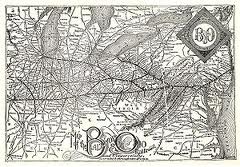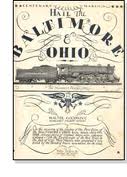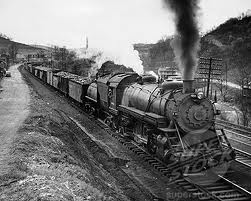The Historic Baltimore & Ohio Railroad
Part 1: Growth and Many Firsts
Construction began in earnest in 1828, with the ground-breaking administered by Charles Carroll, a signer of the Declaration of Independence. In 1829, the B&O launched the first American-built locomotive, the Tom Thumb. The first passenger and freight station appeared the same year, in Mount Clare. (It was from this station in 1844 that Samuel F.B. Morse sent his famous telegraph message: "What hath God wrought?") Track continued to be laid, and eventually trains ran full-time on the line. The first part of the line was entirely in Maryland, from Baltimore in the extreme east to Sandy Hook in the west. The very first section opened for business in 1830, complete with a published timetable and a one-way fare for a one-and-one-half-mile journey of 9 cents. Expansion continued, and the line crossed the Potomac River and stretched into Virginia and then back into Maryland, at Cumberland. A charter for building a line from Baltimore to Washington, D.C., came in 1831. Construction continued during the next several years, and the line reached Wheeling on January 1, 1853.
That same year, the railroad was on both ends of John Brown's raid on the federal arsenal at Harpers Ferry. During the raid, abolitionists stopped the train. John Garrett, the railroad president at the time, sought help from the federal government, and another B&O train transported federal troops (led by Robert E. Lee) to capture Brown and his band. With the growth of the railroad came a large increase in the amount of freight, passengers, and profit coming into city coffers. Baltimore became one of the country's richest cities. Then, the Civil War began.
Next page > The End of the Line > Page 1, 2 |
|
Social Studies for Kids
copyright 2002–2025
David White



 The Baltimore & Ohio Railroad was in existence for more than 160 years before being absorbed into a larger organization. However, the B&O will always be remembered as America's first common-carrier railroad.
The Baltimore & Ohio Railroad was in existence for more than 160 years before being absorbed into a larger organization. However, the B&O will always be remembered as America's first common-carrier railroad. Baltimore, Maryland, was a city growing fast in the early part of the 19th Century. The city's location in the middle of the Eastern Seaboard and on a natural port made it a good candidate for a trade center, and so it developed, with trade going north-to-south, south-to-north, and east-to-west. The growth of canals as trade routes, most notably the 1820 opening of New York's Erie Canal, spurred the development of railroad lines; and in 1827, a group of 25 merchants and bankers pooled their money, totaling $3 million, and set up the railroad. Most prominent among this group of wealthy Americans were George Brown and Philip Thomas, who had spent the year before studying railroads in England. The Baltimore part was easy enough to assign. The Ohio part was the Ohio River, where the railroad eventually reached, at Wheeling, (then not West) Virginia. Maryland granted a charter on February 28, and it could all begin. When the Baltimore and Ohio Rail Road Company was incorporated on April 24, 1827, Thomas was its first president and Brown its first treasurer.
Baltimore, Maryland, was a city growing fast in the early part of the 19th Century. The city's location in the middle of the Eastern Seaboard and on a natural port made it a good candidate for a trade center, and so it developed, with trade going north-to-south, south-to-north, and east-to-west. The growth of canals as trade routes, most notably the 1820 opening of New York's Erie Canal, spurred the development of railroad lines; and in 1827, a group of 25 merchants and bankers pooled their money, totaling $3 million, and set up the railroad. Most prominent among this group of wealthy Americans were George Brown and Philip Thomas, who had spent the year before studying railroads in England. The Baltimore part was easy enough to assign. The Ohio part was the Ohio River, where the railroad eventually reached, at Wheeling, (then not West) Virginia. Maryland granted a charter on February 28, and it could all begin. When the Baltimore and Ohio Rail Road Company was incorporated on April 24, 1827, Thomas was its first president and Brown its first treasurer. The freight loads, passenger numbers, and profits grew along with the number of miles of track. In 1854, the railroad could boast of 380 miles of track. The number of investors grew as well. The company's early decision to issue shared of stock turned into a reward for investors in 1859, when the company for the first time distributed profits to its shareholders.
The freight loads, passenger numbers, and profits grew along with the number of miles of track. In 1854, the railroad could boast of 380 miles of track. The number of investors grew as well. The company's early decision to issue shared of stock turned into a reward for investors in 1859, when the company for the first time distributed profits to its shareholders.
